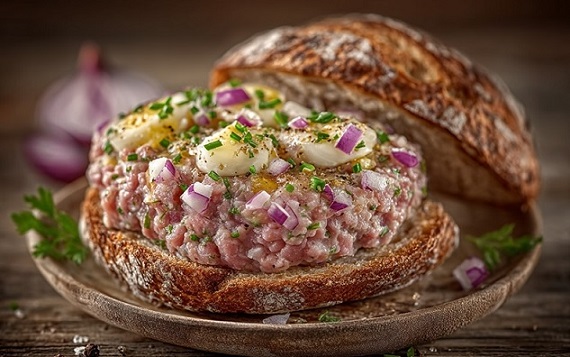
Germany has a long tradition of enjoying raw pork dishes, but if you’ve spent any time exploring regional German foods, you might encounter two confusingly similar terms: Mett and Hackepeter. Both refer to minced raw pork and are often served on bread rolls with onions – but they aren’t quite the same thing.
So what exactly is the difference between Mett and Hackepeter? Are they regional variants, or are they entirely distinct in how they’re made and served? In this article, we’ll unpack the culinary and cultural nuances of these two classic German dishes.
What Is Mett?
Mett is the more widespread and general term. In most parts of Germany, Mett refers to raw, finely minced pork seasoned with just salt and pepper, sometimes garnished with chopped onion. It’s commonly served on a crusty roll, making the beloved Mettbrötchen.
Key Features of Mett:
- Made from high-fat pork, usually neck or shoulder
- Finely minced, often double-ground
- Lightly seasoned (salt, pepper only)
- Often shaped or spread into portions by hand
- Served raw, on rolls or as part of cold buffets
The term Mett comes from the Old Saxon word meti, meaning “minced meat.” Mett is sold widely in bakeries, butchers, and grocery store counters – especially in northern and western Germany.
Explore more about this staple in our article: What’s in a Mettbrötchen?
What Is Hackepeter?
Hackepeter, also sometimes written Hackepeterfleisch, is essentially spiced raw minced pork, associated mostly with eastern Germany, particularly Berlin, Brandenburg, Saxony, and Thuringia. The dish shares a lot in common with Mett, but has notable differences in preparation and usage.
Key Features of Hackepeter:
- Finely minced raw pork, but with added spices
- Typically includes onion, paprika, garlic, and caraway
- Sometimes mixed with egg yolk, especially in restaurant settings
- Often served as part of formal cold platters
- Shaped into decorative forms like balls or spreads
The word Hackepeter likely comes from gehacktes Fleisch (chopped meat) combined with a playful suffix – possibly influenced by old dialects or butcher shop slang.
In Berlin, you’ll frequently see Hackepeter served as a spread on rye bread rather than a roll, and it’s usually more heavily seasoned than Mett.
Summary Table: Mett vs. Hackepeter
| Feature | Mett | Hackepeter |
|---|---|---|
| Region | West and North Germany | East Germany (Berlin, Saxony) |
| Meat Type | Raw minced pork | Raw minced pork |
| Texture | Smooth, fatty, lightly seasoned | More coarsely minced, spiced |
| Seasoning | Salt, pepper | Onion, garlic, paprika, caraway |
| Common Serving | On rolls (Mettbrötchen) | On rye bread or buffet platter |
| Shape | Spread or mound | Often shaped, sometimes decorative |
| Variations | Basic with onion garnish | Includes egg yolk in formal settings |
Historical Origins and Cultural Context
Mett: From the Butcher to the Breakfast Table
Mett originated as a way to consume ultra-fresh pork from local butchers. It was especially common in working-class communities and industrial towns, where people relied on quick, protein-rich snacks. Its simplicity made it accessible and affordable.
Today, Mett is still part of German breakfast culture, especially in the form of Mettbrötchen – available in bakeries, supermarkets, and office catering trays.
For more, see The Cultural History of Mettbrötchen.
Hackepeter: A GDR Favorite
Hackepeter rose to prominence in East Germany (GDR) during the mid-20th century. Because spices were more available than processed foods, cooks used seasonings to enhance dishes without needing many ingredients.
It was often served at state functions, buffets, and formal gatherings, especially as part of the Kalte Platte (cold cuts spread). Even today, Hackepeter is associated with nostalgia for pre-reunification food culture in eastern regions.
Modern Usage and Availability
Where You’ll Find Mett Today
- Butcher counters (Metzgereien)
- Supermarket breakfast sections
- Train station bakeries
- Office breakfasts and cold buffets
- DIY at home (if proper hygiene is followed)
Where You’ll Find Hackepeter Today
- Traditional East German restaurants
- Buffets and party trays in Berlin or Dresden
- Specialty butcher shops in Brandenburg or Saxony
- Home kitchens in the former East Germany
It’s worth noting that most butchers in Germany know the distinction, and some offer both types depending on location.
Which One Should You Try?
If you’re in Germany and curious to sample raw pork dishes safely, both Mett and Hackepeter are excellent options. But your choice may depend on your taste preferences:
- Prefer minimal seasoning and soft textures? Start with Mettbrötchen.
- Want something more flavorful and complex? Try Hackepeter on rye bread.
If you’re outside Germany, preparing either dish is only recommended if you can guarantee safe, parasite-free pork and follow strict food safety procedures. Cooking the meat is always an option for a safer twist.
For a step-by-step tutorial, try our Mettbrötchen Recipe – or cook it to create a safe variant.
Common Misconceptions
1. Mett and Hackepeter are the same
Not quite. While both are raw pork, their regional roots, seasoning, and presentation differ significantly. Think of them as close cousins rather than twins.
2. Hackepeter includes beef
Historically, no – but in some modern twists, you might find Hackepeter-style beef tartare in upscale restaurants. That said, the original Hackepeter is strictly raw pork.
3. You can prepare either dish with supermarket ground pork
Absolutely not. Only pork labeled and prepared specifically for raw consumption (e.g., Schweinehackfleisch zum Rohverzehr) is safe to eat raw in Germany. Outside Germany, this kind of pork may not be available at all.
Culinary Twists and New Takes
Modern German chefs sometimes play with these traditional dishes, creating hybrids or elevated versions:
- Hackepeter crostini with pickled radish and microgreens
- Mett sliders using pretzel buns and gourmet mustard
- Mett tartlets with quail egg garnish
- Vegetarian Mett made from lentils or sunflower seeds (especially popular in Berlin’s vegan cafes)
These dishes reflect both a respect for tradition and a willingness to reinvent, keeping the culinary conversation alive.
While Mett and Hackepeter may appear nearly identical at first glance, they tell two different stories – one of northern simplicity, the other of eastern spice and presentation. Together, they represent Germany’s regional richness, butcher shop traditions, and the national trust in food craftsmanship.
Whether you’re eating a Mettbrötchen at a Hanover train station or trying Hackepeter on rye at a Berlin buffet, you’re experiencing more than just raw meat – you’re tasting a cultural legacy that defies culinary expectations and embraces confident simplicity.







